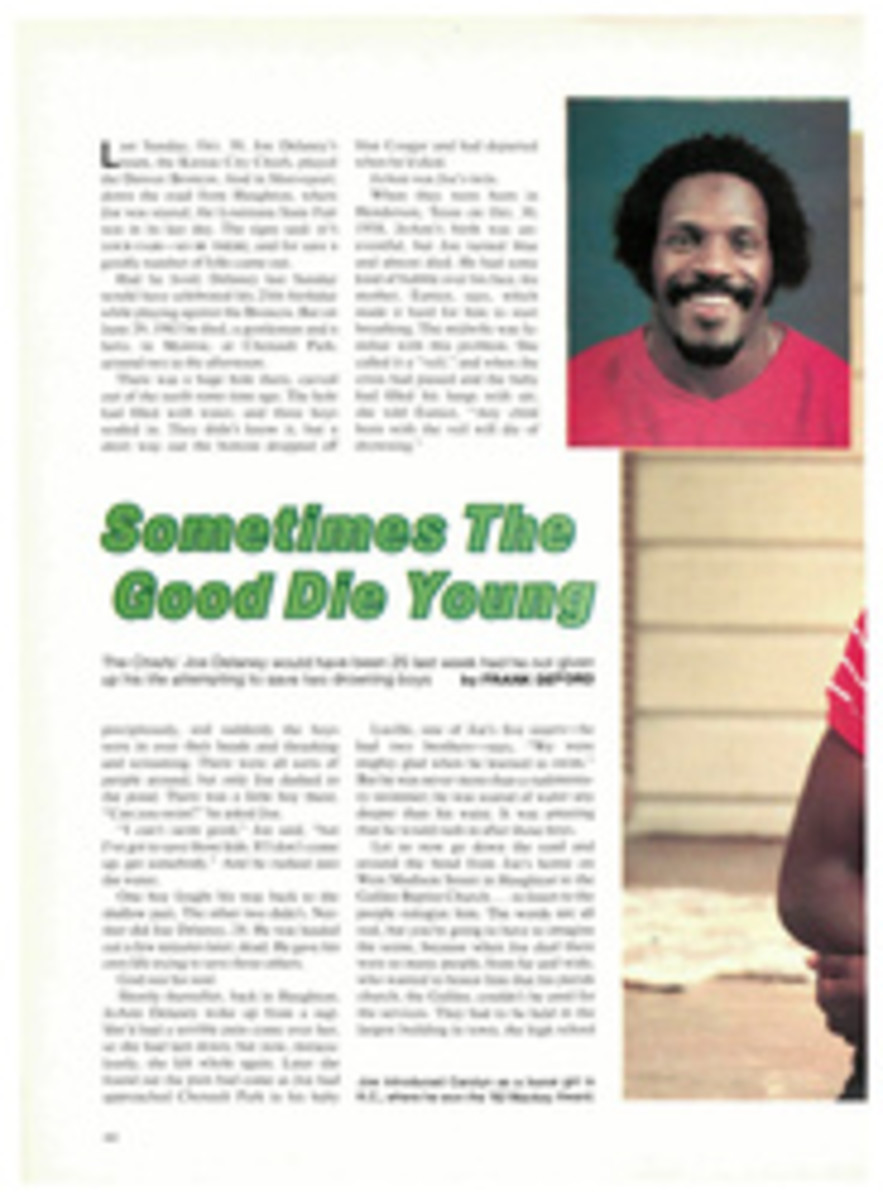
The next stop: Outer Space
In the Budapest Sports Hall last week, the world's top gymnasts were making goulash of the sport's standards, and the U.S.S.R.'s 16-year-old Dmitri Belozertchev was the one doing the best cooking. Watch him twirling around the high bar in a one-arm giant swing. How much can human bone and sinew take? Does one-arm refer to the circles or to what the gymnast has left after he finishes this maneuver? These were the biennial world championships, but what price glory? At the top of one circle, Belozertchev just let go of the bar. He hung there for a second, a Sputnik of the '80s, and then he grabbed the bar, twirled around and let go again. What finally brought him back to earth was a double-twisting, double-reverse somersault. If that seems like a risky way to conclude a dizzying trip, then hang around for another 60 seconds for Belozertchev's last routine of the day, his floor exercise.
Take a deep breath and clean your glasses. Belozertchev did "somis," or somersaults; he did sideward somis, twisting somis and double somis with his body straight. From a sitting position, he whirled his legs and hips in wide, swift circles, only his palms touching the floor. He'd lift one palm and then the other to let his lower body sweep through another revolution. What was he using for stomach muscles, steel plates? When he swung into the sport's toughest handstand, arms way apart, his legs scissored wildly, high above. Seconds later, after two backward midair somis left him standing, triumphant, every one of the four judges flashed out a perfect 10, making the 145-pound, 5'6" Belozertchev the youngest male all-around world champion in gymnastics history.
His sport was a winner, too, albeit a problem-laden one. Three hundred and ninety-nine men and women from 41 countries had received an average score of 9.5 per exercise, the highest ever for a world championship. Twenty-two 10s had been given out, with the individual apparatus and women's all-around finals still to come. Frank Edmonds of England, vice-president of the Fédération Internationale de Gymnastique, was asked, "Has the 10 been devalued?"
"The top gymnasts are doing movements of such originality, risk and perfection that they can't help but score 10s," he said. "The FIG will have to review the situation."
It had better get moving, especially with the Olympics coming up next summer. Belozertchev has no intention of resting on his laurels. At a press conference, someone wondered, "How can you improve? You seem nearly perfect." He responded, through his interpreter, "The complexity, difficulty and execution of the exercise can be increased."
"Do you remember when you first became interested in gymnastics?" he was asked. "On the 20th of November 1973," he replied. "It was my first day to the gymnasium, and I was not accepted, but I improved my knowledge and techniques and I became a gymnast." And how. But that was as much personal information as he was willing, or able, to reveal. One reporter, apparently hoping to get a rise from him, asked, "What do you think about your enemies, the Chinese?"
This was a reference to the finals of the team championship earlier in the week in which Japan finished third and the U.S. fourth. China, which had been out of world team competition for 17 years before 1979, was moving in on its first title. It led the Soviet Union by one-tenth of a point with five of six events completed. China went to the high bar, the Soviets to the floor exercise, and after four men from each team had run through their routines, China was in front by one quarter of a point. Then Yuri Korolev got a 9.85, and Li Ning, all-around winner of last year's World Cup, fell from the bar—an automatic deduction of one-half point. He remounted, came up with a 9.45, and China trailed by .15 of a point. But in team competition, the lowest recorded score is deducted. China had a chance. Belozertchev collected a typically dazzling 9.95, and Bogdan Makouts' 9.75 was expunged from the U.S.S.R. total. The final Soviet score was 591.30, to the Chinese 591.45.
China's destiny was in the hands of Tong Fei, runner-up to Li in the World Cup. He needed a 9.85 for victory: a fall, and China would lose. The next seconds would be the most important of his life, and some of them were spent in beautifully precise one-arm giant circles, followed immediately by a Gienger somersault: Tong let go of the bar, did a back somersault, turned his body 180 degrees and then regrabbed the bar. It's a difficult move to execute under any circumstances, but it was nearly unbelievable that anyone would try it—and execute it so masterfully—coming out of a one-arm giant swing. Tong, a 22-year-old native of Jiangxi Province, got a 9.9. Li's 9.45 was forgotten. Chinese sport had a new hero, and the People's Republic's coach, Gao Jian, was moved to tears.
Tong entered the last day of all-around competition in a tie with Belozertchev, with Li only .15 of a point behind them. But Li, in his second routine, fell from the pommel horse, scored a 9.4 and was out of the running. Then Tong fell from the high bar, and Belozertchev was never challenged again. Of his "enemies, the Chinese," he said, "I was very strong in this competition, and I am sorry two Chinese made major errors. I would have been happy for them to be at their best."
The Soviet coach, Leonard Arkaev, was asked, "Yuri Korolev was the youngest men's world champion ever, at 18. That was two years ago. Now Belozertchev is only 16. How old will the next champion be?"
"Eighteen," Arkaev said, grinning at his prize pupil, Belozertchev.
Is Korolev, who didn't even qualify for the all-around, washed up at 21? And what about his teammate Olga Bitcherova, who had won the '81 worlds at only 14, the youngest woman ever to do so? At Budapest she failed to qualify for the women's all-around. But what happened there should give heart to all such golden-agers. The Soviet women beat Romania and East Germany for the team title, and their big gun was Natalia Yurtchenko, 18. Despite her advancing years, she was obviously in complete possession of all her faculties—going into the last day of women's all-around, she was No. 1, with .15 of a point lead over Romania's Lavinia Agache, no spring chicken either, at 17.
Yurtchenko is a strikingly beautiful dark-eyed young woman who seems much larger than her 5'1" and 99 pounds. It may be because of the way she carries herself, head held high and back, the proud posture of many great female gymnasts. Of course, it may also be because the average height of female gymnasts these days seems to be about 3'4". Yurtchenko has presence, just as Belozertchev has. While she was doing a backward somi onto the vaulting horse and racking up a 10, Agache was falling off the beam and coming up with a 9.35. Scratch one threat. As Yurtchenko whirled around the uneven bars, fifth-place Maxi Gnauch of East Germany followed Agache off the beam. Scratch another.
The beam seemed jinxed on this day, and now Yurtchenko took her turn on it. She did two back handsprings, landing on her feet each time, and then, instead of prancing and pirouetting up and down the beam, as most other female gymnasts do, she turned at right angles and began a series of hip circles around it, above and below it, fluid, flowing, lovely to see. She capped her routine with a double reverse somi dismount. It gained her a 9.9, and after a 10 in her floor exercise, Yurtchenko was the new women's champion.
The U.S. women's team, which was not at top strength because of injuries, finished seventh. The durable 23-year-old Kathy Johnson was 11th in the all-around, with Julianne McNamara coming in 16th.
Of the U.S. men, Mitch Gaylord finished eighth in the all-around, followed by hardy perennials Peter Vidmar, ninth, and Bart Conner, 11th. Gaylord's eighth was only one point off the 118.25 second-place score of Koji Gushiken of Japan. "Mitch could have picked up half a point just by improving his landings," said his coach, Art Sherlock. "He's a logical contender for a bronze in L.A."
By the end of Sunday's apparatus competition, 11 more 10s had been added to that earlier total of 22. Three of them were awarded to Belozertchev, in the pommel horse, rings and high bar.
Watching Belozertchev, someone asked: "What can the FIG require to increase the degree of difficulty for a 10? Make the gymnasts fly?"
If they do, Belozertchev will.
ILLUSTRATION
PHOTO
Belozertchev, 16, has launched the sport into orbit.
PHOTO
Flair: Belozertchev has it, both on and off the bars.
TWO PHOTOS
Bottom up to the top: Women's champ Yurtchenko works parallel to the balance beam, too.

